
Linux Clean History: A Comprehensive Guide to Maintaining Privacy and System Integrity
In the realm of computing, where every command executed and every file accessed leaves a digital footprint, maintaining a clean and secure system history is paramount. For Linux users, who pride themselves on the flexibility and transparency of their operating system, understanding how to manage and clean the command history can be a crucial skill. This guide delves into the intricacies of Linux history management, explaining why cleaning your history is important, how to do it effectively, and the best practices to ensure your privacy and system integrity.
Understanding the Importance of Clean History
Linux, known for its robust command-line interface(CLI), logs every command entered by the user in a hidden filecalled `.bash_history`(or`.zsh_history` for Zshusers). This history feature is incredibly useful for recalling commands, debugging, and learning. However, it also poses a significant privacy risk. Sensitive information such as passwords, personal data, or even illegal activities can inadvertently be logged, exposing users to potential security breaches if their systems are compromised.
Moreover, a cluttered history file can make it difficult to find important commands, especially for users who work extensively through the terminal. Cleaning your history periodically not only mitigates privacy concerns but also enhances productivity by maintaining a tidy and organized command log.
Why and When to Clean LinuxHistory
Before diving into the technicalities, lets explore the scenarios where cleaning your Linux history becomes essential:
1.Privacy Concerns: If youve entered sensitive information like passwords, credit card numbers, or personal details via the terminal, its crucial to remove these entries to prevent unauthorized access.
2.Compliance and Security: In some professional environments, particularly those governed by strict data protection laws(e.g., GDPR, HIPAA), maintaining a clean command history can be a legal requirement.
3.Productivity: Over time, your history file can grow substantially, making it cumbersome to navigate. Regular cleaning helps keep the file manageable.
4.Error Correction: Mistakes happen. Sometimes, you might enter commands that could compromise system stability or security. Removing these commands from the history prevents accidental re-execution.
5.Sharing Environments: In shared computing environments, such as universities or workplaces, maintaining a clean history ensures that your personal or confidential work doesnt become visible to others.
How to Clean Linux History
Now, lets get into the practical aspects of cleaning your Linux command history. There are several methods you can use, depending on your needs and level of comfort with Linux.
1. Manually Clear History
The simplest way to clear your bash history is by using the`history` and`clear` commands, although these have slightly different effects:
- `history -c`: Clears the current shell sessions history in memory.
- `cat /dev/null > ~/.bash_history`: Erases the contents ofthe `.bash_history` file, effectively clearing the saved history.
- `rm ~/.bash_history && history -c &&exit`: Deletes the history file, clears the current sessions history, and exits the shell. Upon re-login, a new, empty history file will be created.
2. Interactive HistoryEditing
For more granular control, you can editthe `.bash_history` file directly using a text editorlike `nano`,`vim`, or`gedit`:
nano ~/.bash_history
This method allows you to delete specific commands by manually selecting and removing them. Save and close the file after making your changes.
3. Using History Control Commands
Bash provides built-in commands to control what gets logged:
- `set +o history`: Disables history logging for the current session.
- `set -o history`: Enables history logging(defaultbehavior).
- `HISTCONTROL`: A variable that controls which commands are saved to the history file. For example, `export HISTCONTROL=ignorespace` makes bash ignore commands prefixed with a space.
- `HISTIGNORE`: A colon-separated list of patterns for commands that should not be saved to the history. For example,`export HISTIGNORE=ls:cd:exit` ignores`ls,cd`,and `exit` commands.
4. Automating History Cleanup
For regular and automated cleanup, you can add commands to your shell configurationfile (`.bashrc` or`.zshrc`):
Clear history when logging out
alias logout=clear_history_and_logout
function clear_history_and_logout{
history -c && rm -f ~/.bash_history && exit
}
Clear history at the start of a new session(optional, may not be ideal for all users)
history -c && cat /dev/null > ~/.bash_history
Note: Be cautious with automated cleanup scripts, especially those that delete history at the start of a new session, as they can inadvertently remove valuable historical data.
5. Using Third-Party Tools
While not strictly necessary, some users may prefer using third-party tools for more advanced history management. Tools like`zsh-histdb`,`bash-preexec.sh`,and `histdb` offer enhanced features such as searching, tagging, and filtering of command history.
Best Practices for Maintaining a Clean History
While knowing how to clear your history is important, adopting best practices can help prevent the need for frequent cleanup:
1.Use Temporary Variables: Avoid typing sensitive information directly into the terminal. Instead, use temporary variables that are deleted once used.
2.Aliases and Functions: Create aliases or functions to avoid repeatedly typing sensitive commands. For instance, create an aliasfor `ssh` that prompts for a password securely.
3.Read-Only History Files: If youre in a high-security environment, consider makingthe `.bash_history` file read-only, preventing accidental modifications or deletions.
4.Regular Audits: Periodically review your history f

